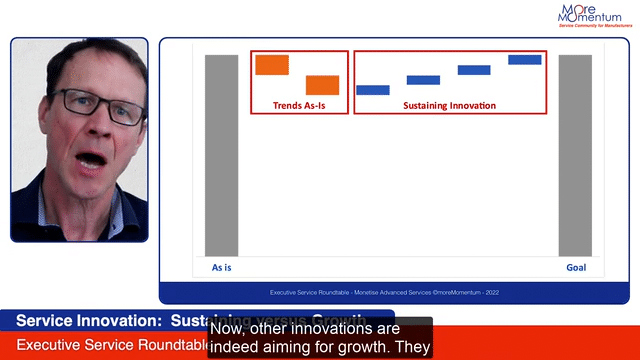How to monetise advanced services
Value propositions in manufacturing are becoming more data-driven and more service-oriented. It is critical to generate and capture the new value.

A common mistake is to solve small problems of customers. These are necessary improvements, but will not bring any growth or opportunities to monetise.
This article is the second of my series of five in which I cover 4 critical steps which make the difference between success and failure in monetising services and data:
Read my introduction to this topic in Why it is important to monetise services and data
One of the common mistakes is to focus too much on only small problems of clients and on incremental improvements of existing services or client-solutions. These are typically the standard logical next step improvements most of the competitors bring to the market as well.
Although these improvements are necessary to sustain your market position, they will not bring much growth or opportunities to monetise. Just think about the new features car-manufacturers add to their new models or the weekly updates on our computers and office-software. We get them without paying more.
Another common mistake is to focus too much on the availability and uptime of the equipment. In many industries, clients already have solved this problem pretty well and are not anxious to pay a lot more for better uptime. On the contrary, they would rather pay less and actually see predictive maintenance capabilities as a way to make uptime cheaper. That is de-monetising services.
While the sales of trucks was shrinking dramatically, one of the leading truck manufacturers – MAN – experienced that discounting the trucks did not have much impact on decision of their clients to buy new trucks. They discovered that one of the big challenges for truck operators was reducing fuel consumption. MAN took this challenge beyond the typical product thinking, which is improving aero-dynamics and engine efficiency. They developed data-driven services to reduce fuel consumption by improving the way truck-drivers drove the trucks.
By adding value in solving big problems, MAN managed to increase their market share with 50%, without reducing the price of their equipment.
The ideal practice is to create significantly more value for your clients and to increase your relevance for them by:
This all starts with having a deep understanding in your clients business, their operations and challenges. This is easier said than done. The challenge is to discover, recognise and appreciate new insights into other customer needs which used to be neglected as they were not considered as part of the core business of an equipment manufacturer.
Here are some practical approaches to prevent bias from long-standing experience and business-as-usual:

These practices mentioned above will give you a lot more insight on customer needs.
Next is to explore which of these client needs you could and should be addressing now or in the future. With these insights you can extend and enhance your vision, strategise and roadmap to innovate your services and to generate new revenue streams.
Manufacturers that are better at solving bigger customer problems build a better position to differentiate themselves from their competitors and grow their overall business.
The main challenge for manufacturers is to develop a deeper insights in the challenges and problems of their clients without bias from their current business model.
Subscribe for the our Impulse Letter
With regular updates about service news, trends and best practices.

Value propositions in manufacturing are becoming more data-driven and more service-oriented. It is critical to generate and capture the new value.

Monetising advanced services is a mission-critical capability for a successful service transformation. After all, we are all on an exciting journey...

Many services businesses struggle when it comes to monetising advanced services, like you have remote services, predictive maintenance, and other...